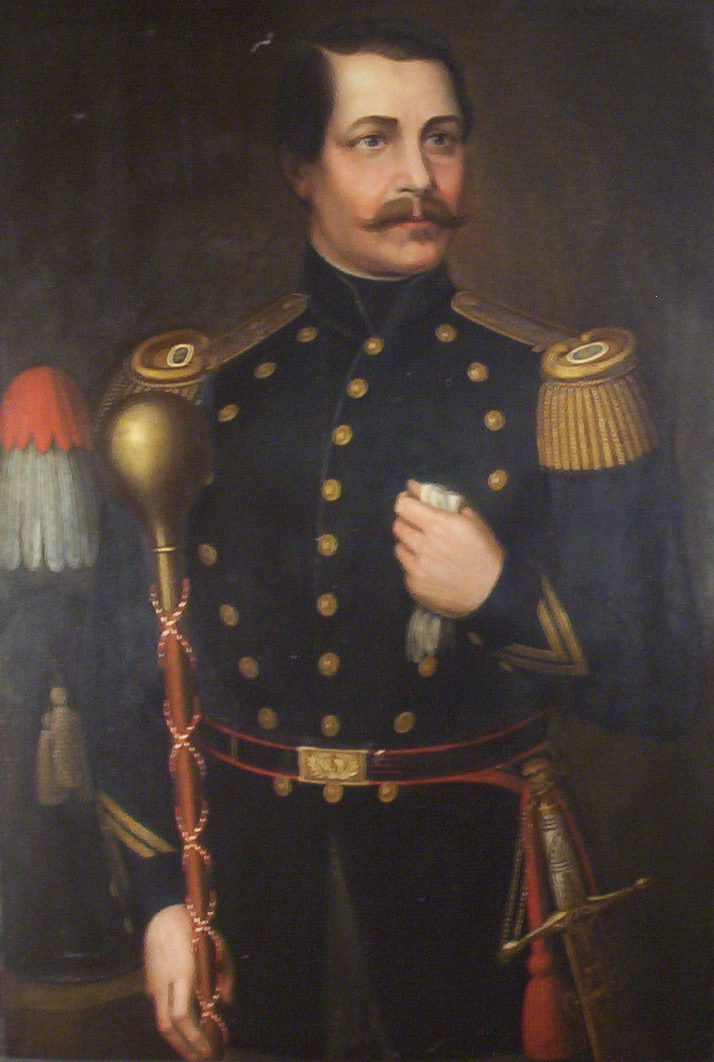German Immigrant Ancestors
in Syracuse and Onondaga County, New York
The ANDERSAG Monument
Lana, South Tyrol, Italy
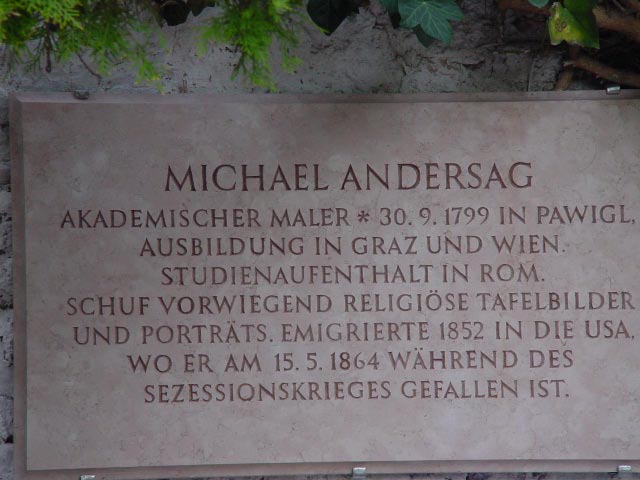
MICHAEL ANDERSAG
Academician Painter born 30 September 1799 in Pawigl,
Trained in Graz and Vienna,
Lived and studied in Rome.
Created predominantly religious murals and portraits.
Emigrated in 1852 to the USA
Where on 15 May 1864 he
Fell during the Civil War.
The memorial plaque pictured above is erected in the municipality of Lana in the South Tyrol (Austrian territory prior to 1919; now part of northern Italy). It stands as a monument to a native son from the nearby small agricultural village of Pawigl, and was dedicated on 15 May 2004, the 140th anniversary of his death. Although this monument is a long way from Onondaga County, New York, it memorializes the life and achievements of both a distinguished Austrian painter and a patriotic American citizen of Syracuse. It also represents the culmination of an interesting story of research by one of his family’s descendants.
Michael Andersag was born on 30 September 1799 in Pawigl near Meran in the South Tyrol (today known as Merano, Italy). His talent and enthusiasm for art were evident at an early age and were encouraged by his mother and, later, by a succession of mentors. He attended painting academies in Graz, Munich, Vienna (1822-1824), and Rome (1825-1834). From 1837 to 1851 he worked in the South Tyrol, the North Tyrol, and Bavaria, primarily doing religious murals and portraits. Following the death of his patron, the Abbot of Wilten, in Innsbruck in 1851, Michael Andersag left Austria headed for the United States.
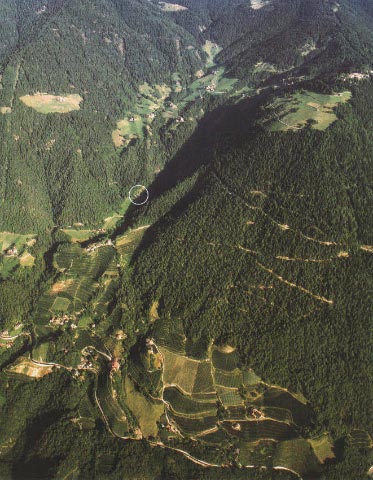
Michael Andersag’s birthplace (circle) in the South Tyrol
near Lana
as it looks today.
He arrived in New York City aboard the ship “Woodside” from Le Havre on 2 September 1852. His plan was to become a teacher of art at the Polytechnic School in Williamsburgh (most probably the village by that name which later was incorporated as part of Brooklyn, New York). But nothing is known of his whereabouts until 14 September 1853, when he filed paperwork in Onondaga County declaring his intention to become a U.S. citizen.
Thereafter Syracuse city directories list him as follows:
1855: artist, boards at Lock Street
1857: artist, studio is on the 3rd story of Everson Block
In 1859 and 1860 he is neither mentioned in the city directory nor in the census records of Syracuse.
1862: artist, studio and home at 207 North Salina Street
Michael Andersag from “Austria” became a naturalized U.S. citizen in Syracuse on 7 October 1857, when he officially swore allegiance to his new homeland. Two other German pioneers of Syracuse, Peter Ohneth (Captain of the “Empire” No. 4 firefighting company, immig. 1845 from Darmstadt) and Friedrich Schug (emig. 1848 from Ulmet, Rheinpfalz), served as his character witnesses.
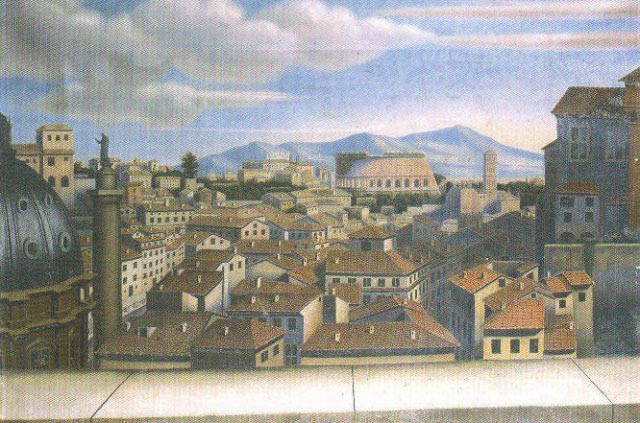
City View of Rome
Painting by Michael Andersag, 1828
He worked as an artist in Syracuse for several years and must have been successful at it. He was well-known in the Syracuse German community and was evidently well-liked as a man willing to express his views, a writer, and something of a character who was interested and involved in local political events.
When the Civil War broke out in 1861, Michael Andersag evidently joined the majority of his fellow Germans in responding with strong feelings about the need to fight for “freedom, liberty, and union” in his adopted country. The following year, in response to President Lincoln’s second proclamation calling for troops, and despite his advanced age of 62 years, Michael Andersag enlisted as a private in the mostly-German Company B of the 149th New York Volunteer Infantry Regiment. He signed on for a three-year hitch or until the war was won, and went with the Company to fight for the Union cause when they left Onondaga County for points south in September.
Three days before his Company was mustered in, Andersag, who had never married, made a will, which read as follows:
I, Michael Andersag, of the city of Syracuse, County Onondaga, State of New York, 62 years old and being of sound mind and memory make public and declare this to be my last Will and Testament, in the following manner. . . .
First – all monies belonging to me and deposited in the Onondaga Savings Bank after my death [are] to be divided among the poor wives and children of the German soldiers of Syracuse and at present engaged in the service of the United States in the war.
Second – All paintings of Art which I have deposited for safe keeping with Mr. George Meier [sic], No. 302 Lodi Street, – Second Ward, [are] to be sold in a most-convenient manner and the money derived therefrom to be disposed for the above mentioned purpose. For the execution of this my last Will I nominate the Misters George Saul, George Meier and Benedict Haberly [sic; Haberle] with the request to execute the same.
In witness whereof I have hereunto subscribed my name. So done [at] Syracuse the 14th day of September in the year one thousand eight-hundred and sixty-two.
(Signed) Michael Andersag, Artist
Witnesses: Philip Eckel and Philip Hirsch
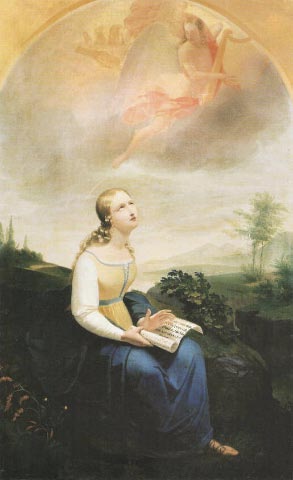
“Heilige Cäcilia (Saint Cecilia)” – 111.5 x 175.5 cm
Oil painting by Michael Andersag, 1824
On 23 September 1863 the soldiers marched down Salina Street and were taken via the New York Central Railroad to Geneva, New York. From there they were sailed by steamship across Seneca Lake to Watkins Glen, and then went by train to Elmira, where they were issued arms. Following that, they were stationed in Williamsport, Baltimore, and Washington, D.C.
While away at war, Andersag wrote several letters back home to the editor of the Syracuse Journal, who evidently was a friend. As was the custom of the times, the editor turned the personal anecdotes in the letters into good “war stories” to be published for the homefront audience. The following article appeared in the 5 June 1863 Journal and described the aftermath of Andersag’s capture around the time of the Battle of Chancellorsville, Virginia, 1-3 May 1863, when a large part of his regiment was killed, wounded, or captured and marched to Richmond:
A Gallant Old Soldier
[By the] Editor of the Syracuse Journal:
When, last Fall, the 149th regiment was raised in this city, the Germans organized in the short time of four days, Company B. In this company enlisted an old man by the name of Michael Andersag. He was born in Germany, in the year 1799, consequently at that time already sixty-three years old, but full of life and spirit. He was somewhat eccentric, an artist, a good and patriotic German speaker, and a good writer. He was asked by the examining physician “How old are you?”
“Just old enough to whip a rebel,” was the answer.
This man has borne, since his enlistment, all the hardships better than any in the company. On the 27th day of April he fell, while skirmishing, into the hands of the rebels. He was taken with the others to Richmond [Virginia]. As soon as he arrived there, a rebel officer stepped before the captives and said:
“Is there here a man by the name of M. Andersag, of Company B, 149th Regiment, N. Y. Volunteers?”
Andersag answered quickly, “I am the man.”
He was then conducted to a room, and in the presence of several officers, examined in the following manner:
Question. - “You are over forty-five years of age, what made you enlist?”
Answer - “When the country calls to which you have sworn allegiance, every man has the right, and it is his duty to enlist.”
Q. - “You have come to make sketches and drawings of battlefields.”
A. - “No.”
Q. - “You have made a drawing of Boliver Heights.”
A. - “Yes; but as a picture, and not as a military map.”
Q. - “You have spoken in public meetings against the South.”
A. - “Yes.”
Q. - “Why have you done this?”
A. - “Because I was called by the people.”
Q. - “Why did you publish articles in the paper against the South?”
A. - “Because the Constitution gives me the right to do so.”
After this the examining rebel said: “You shall find in the South a piece of rope and twelve feet of ground.”
To which Andersag answered: “I do not believe it.”
The rebel officer replied: “You will be hung.”
“Very well,” replied Andersag coolly. “Do you believe that when I am hung, your cause is won?”
“The President of the Court Martial smiled and said, “You can go.” but one of the officers said roughly, “Get out, old thing.” Two days afterward he was paroled and is now in camp near Alexandria [Virginia].
Andersag writes to me, “It seems that the Copperheads [Northerners secretly supporting the Confederates] in Syracuse did do me the honor of advising their rebel brothers of my being in the army.” When the news came that A. was a prisoner, one of the leading German Copperheads said: “I’m glad they have him at last. I hope they will make him do the meanest and dirtiest work, like cleaning outhouses,” etc.
This staunch Republican ought to be promoted and not, like many good patriots, neglected.
-------
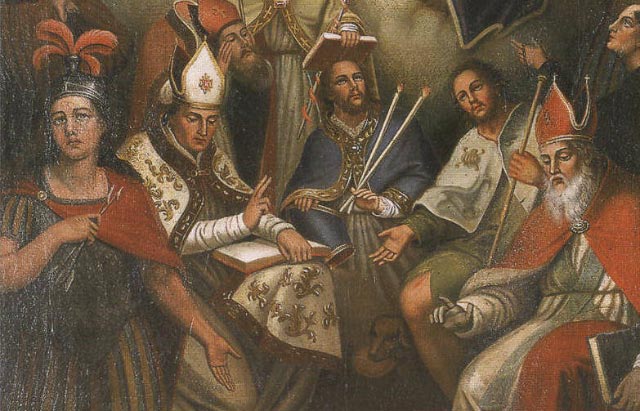
Detail from Vierzehn Nothelfer, Church in Völlan,
64 x 137 cm, restored
Painting by Michael Andersag, 1849
Andersag’s regiment took part in the following battles of the Civil War: Chancellorsville (Virginia), Gettysburg (Pennsylvania), Wauhatchie and Lookout Mountain (Tennessee), and Ringgold, Resaca, New Hope Church, Lost Mountain, Pine Knob, Kennesaw Mountain, and Peachtree Creek in the Atlanta Campaign (Georgia). They also were present at the battles of Missionary Ridge (Tennessee), Rocky Face Ridge (Georgia), and Aversboro and Bentonville (North Carolina). They were part of General Sherman’s famous “March To the Sea” from Atlanta to Savannah, Georgia. In all, 133 men died and 353 were wounded.
Andersag’s unit captured four Confederate battle flags, two at the Battle of Lookout Mountain (24 November 1863) and two in the Battle of Ringgold, Georgia (27 November 1863). Today, three of these flags (Semple’s Battery of the Alabama Light Artillery flag, 34th Mississippi Infantry flag, and 29th Mississippi Infantry flag; the fourth flag is lost) are housed in the Museum of the Confederacy in Richmond, Virginia. Each has its capture legend (“Captured by the 149th N.Y.V....”) inscribed on it in gold by the hand of Michael Andersag. (See Memoirs of the 149th N.Y.V.Infantry from Capt. Geo. Collins 1891.)
But Michael Andersag did not live to come home to Syracuse from the war. On the morning of 15 May 1864, the last day of the bloody three-day battle of Resaca, he was missing, and by that afternoon was declared fallen on the battlefield north of the Oostanula River. A letter signed by a captain of the regiment found in his military records at the National Archives states that there were no remains of Michael Andersag since “his body was burned all to a crisp after being killed” (perhaps in a fire in a barn near the battlefield the previous day). So the gallant old soldier still lies in the red soil northwest of Resaca, Georgia but there is no grave.
Dr. Erich Andersag of Bregenz, Austria, is a descendant of the Pawigl family of Michael Andersag, and it was he who pursued the story of his distinguished relative’s eventful life. Fluent in German and English, Dr. Andersag took advantage of the resources of the internet and was helped and supported by other researchers both in Europe (including the mayor of Lana and a team of Tyrolean art experts organized by Dr. Georg Lösch of Bozen) and from as far away as Texas, Georgia, and Syracuse. The “Michael Andersag Work Team” was able to piece together the details and follow the trail from a tiny valley in today’s northern Italy, through the art schools and churches of Bavaria and the Tyrol, to a German immigrant community that flourished in upstate New York 140 years ago, to a patriot’s final resting place on a battlefield in Georgia. It is due to these persistent efforts that the memorial plaque now stands in Lana, and an exhibition of Michael Andersag’s European work was shown in the Ansitz Rose Garden in Lana from 30 July 2004 through 28 August 2004. A handsome programme/monograph, Michael Andersag 1799-1864: Ein Vergessener Maler aus Pawigl (“A Forgotten Painter from Pawigl”), was published in 2004 in conjunction with the exhibition.
The researchers have found so far only two mentions of specific art works produced by Michael Andersag during the years he spent in the United States. One piece was a painting called “Bolviar Heights” (perhaps the drawing mentioned in the Syracuse Journal article above?); Andersag’s regiment was stationed at Bolivar Heights, near Harper’s Ferry, from October 30 to December 10, 1862. This artwork has not been found. The other is an oil portrait of a Syracuse German-American, John Thurwachter, in his uniform as Drum Major of the 51st Regiment of the New York State Militia, today privately owned in Missouri (see below). Complicating the search for his artwork is the fact that Michael Andersag usually did not sign his paintings.
Because Michael Andersag was a prolific painter, spent several years in Syracuse running an art studio, and had many acquaintances among the German community, we can believe that he may have produced many portraits of his Syracuse friends. Or perhaps he lent his talent to religious purpose in some of Onondaga’s churches as he had done in Europe. His last will and testament would lead us to believe that a quantity of his paintings were sold to support the widows and orphans of the German war martyrs during or after the Civil War years. Could masterpiece portraits of his friends, including Benedict Haberle (brewer of Haberle Congress Beer), George Meier/Meyer (later owner of a hotel, “The Meyers’”), Christian Freeoff, or George Saul be quietly hiding their secrets right now in Syracuse-area attics and basements?
His relative, Dr. Erich Andersag, says it would be a great pleasure to hear of any further details about Michael Andersag’s life or work in the United States. Please write to him at this email address: eande
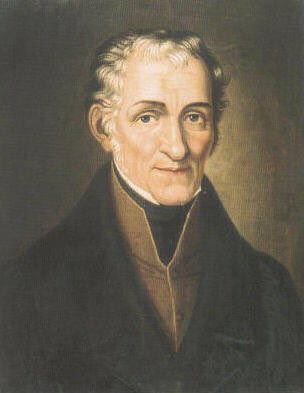
Portrait of Dr. Blasius Pardatscher
Oil on wood, 44 x 56 cm
Painting by Michael Andersag, 1840-1852
The foregoing was written by M. Stone on 6 October 2004 and based on information provided by Dr. Eric Andersag, Pete Pierce, and Geschichte der Deutschen in Syracuse und Onondaga County. Updated 15 January 2010.
Known artworks by Michael Andersag
updated 27 May 2010VIENNA / AUSTRIA
Portrait of his early artmaster, Jakob Pirchstaller (circa 1820) -- formerly in Museum Ferdinandeum, Innsbruck, Austria, now missingROME
Portrait of Frau Großrubatscher (circa 1820) -- formerly in Museum Ferdinandeum, Innsbruck, Austria, now missing. There will be an exhibit about Frau Großrubatscher (a painter in her own right) at Schloss Tirol in Meran, Italy in October 2010
Portrait (in pencil) of a young lady, "Gräfin Waldstein, nee Fuchs" (1823) signed by Michael Andersag in Vienna -- privately owned
Miniature of Madonna of Raphael (1824) -- missing
Hl. Cacilia (Saint Cecilia) (1824) -- Museum Ferdinandeum, Innsbruck, Austria
Family portrait, Count Mamming (1824-25) -- Lana, South Tyrol
Painting, "Descent from the Cross" (copy of original by Daniele da Volterra) (circa 1825) -- It was sold at auction from Museum Ferdinandeum, Innsbruck, Austria in 1871 for 5 Gulden and 75 Kreuzer to Josef Fumagalli, owner of a silk mill in Innsbruck -- now missing
Several copies of Raphael’s paintings (1825-1834) -- missing
Madonna di Foligno (Raphael), altarpiece (1826) -- Convent Wilten, Innsbruck, Austria
Portraits of several popes (Popes Clemens XIII, Clemens XIV, Pius VI, Pius VII, Leo XII, Pius VIII, Gregeor XII) (1825-1834) -- Convent Wilten, Innsbruck, Austria
View of the city of Rome (1828) -- Convent Wilten, Innsbruck, Austria
Painting, "Petrus and Ananias" (1830) -- sold at auction in Innsbruck in 1871 for 35 Gulden and 20 Kreuzer to Mr. Erler, now missing
Maria and Jesus and John (circa 1830) -- missing
Coronation of Maria (by Giulio Romano) (1825-30) -- formerly in Wilten, now missing
Assumption (copy of a painting by Raphael), altarpiece (1828) -- Maria Trost church, Meran, Italy, formerly missing, discovered during the church's restoration completed in 2009
Saint Norbert, altarpiece (date?) -- in Wilten until 1908, now missing
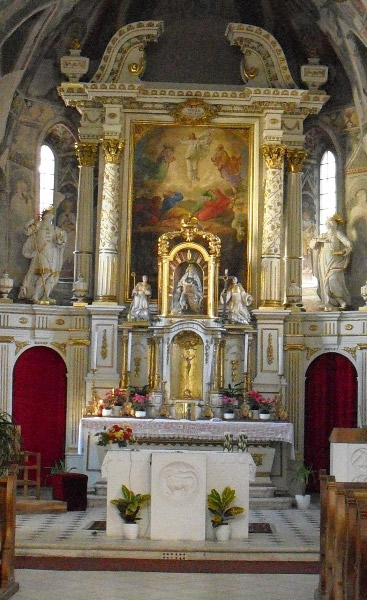
Maria Trost Church, Meran, Italy
Altarpiece by Michael Andersag, 1828
BAVARIA (GERMANY)
"Blessing of Jacob" painting (before 1836) -- missing
Hl. Magdalena (Saint Magdalena) (1836) -- Waakirchen
Hl. Leonhard (Saint Leonhard) (1836) -- Waakirchen
Hl. (Saints) Maria, Martin and Nikolaus (1843) -- Waakirchen
Death of Saint Corbinian (1844) -- Reichersbeuern
Hl. Martin (Saint Martin) (1844) -- Waakirchen
SOUTH TYROL
Coronation of Maria (altarpiece) (1834) -- Church in Marling, missing since 1900
Saint Martin (altarpiece) (1838) -- Church in Girlan
Saint Sebastian (altarpiece) (1839) -- Church in Girlan
Saint Florian and Saint Wolfgang (altarpiece) (1839) -- Church in Girlan
Saint Magdalena (1839) -- Bozen, privately owned
Saint Pankratius (altarpiece) (circa 1839) -- St. Pankraz, Ulten, now missing
Dr. Blasius Pardatscher, portrait (circa 1840) -- Villach, Austria, privately owned
Klara von Aichner, wife of Dr. Blasius Pardatscher, portrait (circa 1840) -- Villach, Austria, privately owned
Saint Ulrich and Otto the Great (fresco) (1846) -- Castle of Salegg
Saint Ulrich and Otto the Great (oil painting) (1846) -- Kaltern, privately owned
14 auxiliary saints (altarpiece) (1849) -- Church in Völlan
Schloss Lebenberg (oil painting of landscape near Meran) (1849) -- Schloss Tirol in Meran, Italy
Mural/wall paintings in house "Ansitz Schasser-Weihrauch-Dipauli" -- Kaltern
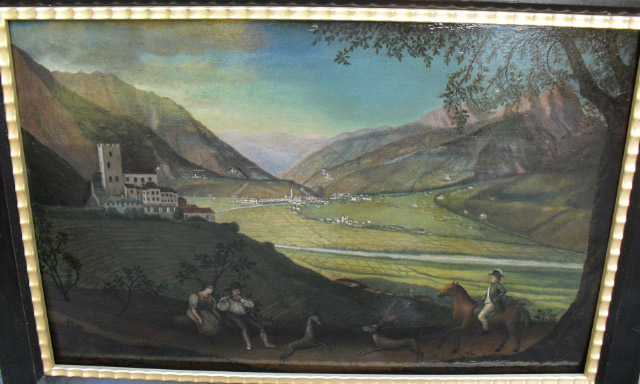
Schloss Lebenberg
Oil painting by Michael Andersag, 1849
USA
Bolivar Heights, near Harper's Ferry, Virginia (1863) -- missing
Drum Major John Thurwachter of Syracuse, New York, in uniform (1859) -- Missouri, privately owned
